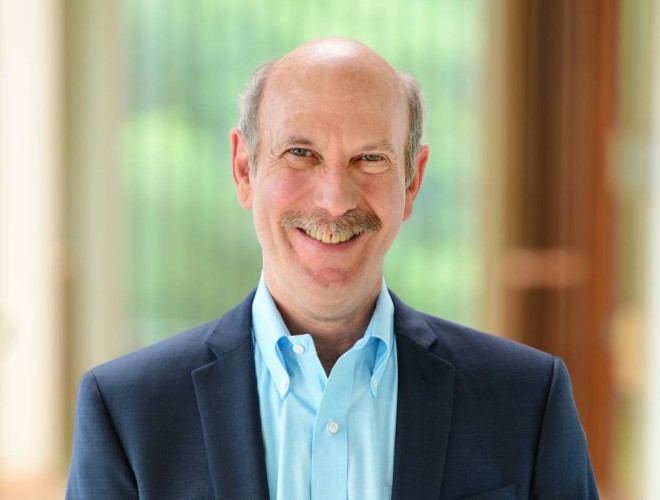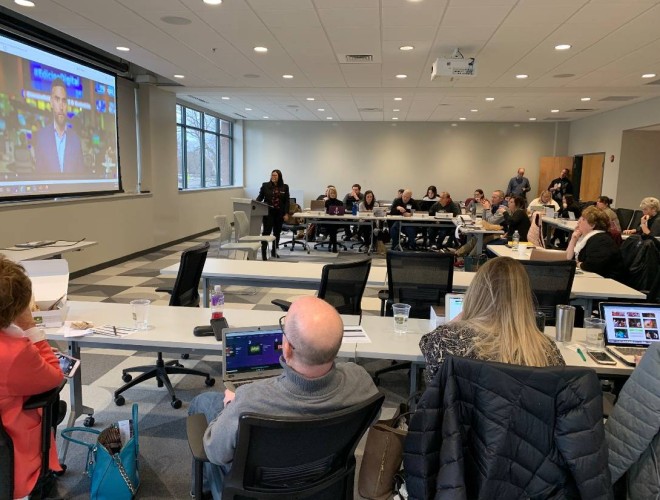The News Literacy Project (NLP), a nonpartisan education non-profit headquartered in Washington, D.C., offers programs and resources to help people discern credible information. NLP’s primary audiences are middle and senior high school students and educators. NLP’s online resource Checkology® (https://get.Checkology.org/) is offered free of charge and has registered users in about 110 countries.
Alan Miller
Alan C. Miller, founder and CEO of the News Literacy Project, is a Pulitzer Prize-winner and a former reporter for the Los Angeles Times. Miller graduated from Wesleyan University and received his M.A. from University of Hawaii. He started the News Literacy Project in 2008.
抄訳「民主主義の危機とニュースリテラシー ~アラン・ミラー氏インタビュー」はこちら
What I realized after being invited to speak at my 12-year-old daughter's school
―― We understand that you started thinking about establishing NLP when you gave a lecture at your daughter's school.
 It was 2006. I was an investigative reporter for the Washington bureau of the L.A. Times, and I was invited to speak to 175 sixth graders about what I did as a journalist and why my work mattered.
It was 2006. I was an investigative reporter for the Washington bureau of the L.A. Times, and I was invited to speak to 175 sixth graders about what I did as a journalist and why my work mattered.
My 12-year-old daughter, Julia, was convinced that I would embarrass her in front of her classmates. But after the lecture, she came up to me and hugged me. So I passed that test.
As I walked across the school parking lot, I found myself thinking, “Wouldn't it be meaningful if more journalists could bring their expertise and experience to the nation’s classrooms?”
That night, Julia came home with 175 handwritten thank you messages. We read each one out loud. I could see what had resonated with the children and what aspects of my talk had helped them to connect with journalism. The experience that day became the germ of the idea for NLP.
―― It was two years later, in 2008, that you launched NLP on your own, wasn’t it?
At that time, I was concerned about two things. First, the business model of newspapers was collapsing, and I wondered if there would still be an understanding and appreciation for the quality journalism to which I and many others had devoted our careers. Second, I was concerned how my daughter, Julia, was accessing and evaluating the news and other information that flooded her daily life with very different levels of credibility, accountability and transparency.
In this day and age, everyone is their own editor and can be their publisher. So we want to empower students to discern credible information for themselves, to play these roles in a responsible and credible way, and to give power to their voice.
So we started by sending reporters into the classroom. We thought that by teaching students how we gather, select, and deliver information to our readers and viewers on a daily basis, they would learn critical thinking skills to know what to believe on the internet.
Over the first eight years, we had more than 30 news organizations as partners and more than 400 journalists participate in the program. These were journalists who worked for newspapers such as The New York Times, The Wall Street Journal, and The Washington Post; television networks such as CNN, ABC, NBC, and CBS; and digital-first outlets such as Buzzfeed, Vox, and VICE. The journalists delivered more than 750 lessons in classes in schools in New York, Chicago, and the Washington, D.C. region and we reached more than 25,000 students.
I was there to observe many of them and to learn what connected with students, what resonated, what worked and what didn’t. We learned a lot about what met the needs of the teachers and how to connect with students.
Children are not equipped to distinguish between fact and fiction
―― What did you see from the back of the classroom?
It was an eye-opening experience for me. One of the things that struck me was that the students may be a generation of digital natives, but they are not well equipped to distinguish between fact and fiction or to judge what is credible. In some cases, they believed that if it was posted on the Internet, it was true and someone must have verified it. Others simply did not know to question what they read. These students believed whatever information their friends sent them through social media, and they were quick to share it without question.
In classes for older students, some students took a cynical view of things, saying that all information is created with commercial, political, or personal bias and hidden agendas. Some argued that blog posts and YouTube videos are more reliable than mass media news because they are unmediated. Of course, if you know who created the video, for what purpose, with what standards, and what is in the front and back the frames that are shown, then there is a chance that this opinion might be correct.
I realized that the content of news literacy education was uncharted territory for most students and educators. Then, I began to think, "Why would educators and students know how journalism works, the difference between news, opinion, and advertising?” Our efforts in our initial classroom program became the foundation for everything we do. We were able to confirm that knowing what news and other information to trust is a widely applicable critical thinking skill, and an essential life skill for the times we live in. Technology moves quickly, but education moves slowly, and it became clear that schools had not kept up with the fact that students were getting most of their information from their devices.
So, there were times when I left these schools feeling very discouraged because I thought, “Wow, what an enormous boulder we’re trying to push up the hill!” At the same time, I became even more convinced of the importance of this work and the opportunities it presented.
I also realized that meeting and talking to quality journalists was an exciting experience for the students. I could see from the students' reactions that we were making a difference.
Identifying Fake News with “Checkology”
―― You have done great work in the field of investigative journalism and have won a Pulitzer Prize. How did you decide to leave the field of journalism?
 I was 53 years old when I left the Los Angeles Times. I had worked as a newspaper reporter for 29 years. Journalism was always more of a calling than a career for me and I wondered if there might be a second act in my career.
I was 53 years old when I left the Los Angeles Times. I had worked as a newspaper reporter for 29 years. Journalism was always more of a calling than a career for me and I wondered if there might be a second act in my career.
When I got the idea for NLP, it felt like a second journalistic calling. I saw it as an opportunity to not only help maintain an appreciation for quality journalism, but also as a way to contribute to the education of the next generation and to give people th
e tools to be well-informed participants in civic life, thus contributing to a healthy democracy.
Leaving journalism at the pinnacle of my career to start something new was an adventure in the truest sense of the word. But I found that it was a natural transition and a wonderfully worthwhile challenge.
In 2016, we launched Checkology, building on all of our experiences to date. We had intended to move to scale throughout the U.S., but had not envisioned that we would end up going global as well.
―― We understand that Checkology is also gaining worldwide interest as a means of distinguishing disinformation and learning critical thinking.
We launched Checkology in May 2016. This was a presidential election that year, and Donald Trump was elected president. A combination of factors, including social media platforms serving as a forum for disseminating harmful information and Russia's attempts to use such platforms to undermine democracy prompted more attention to us from educators and journalists. National Public Radio did a report in the classroom of one of our teacher’s class who was using Checkology with the headline, "The Classroom Where Fake News Fails." We didn't have a marketing budget, but we got initial interest from individual educators, and then Checkology spread by word of mouth.
Our funding sources expanded from foundations and individuals in New York, Chicago, and Washington D.C., to high-tech and social media companies in Silicon Valley and elsewhere. This enabled us to expand our staff and set more ambitious goals.
Although we developed Checkology as a platform primarily for Americans, with lessons in English, including one on the First Amendment, the proliferation of disinformation has become a global issue and is a challenge in many countries. It has been used to incite hatred, violence, and even genocide, and combating it is a "matter of life and death" in many places.
Conspiracy theories have come out of the "internet hangouts" and into the streets
―― In the era of President Trump, there has been a growing recognition of the importance of strengthening democracy by teaching media literacy. Has this had a significant impact on the business of NLP?
Clearly, during President Trump’s administration we saw accelerated attacks on the press from the highest authority in the country, massive amounts of misinformation and increased racial tensions and hyper-polarization in the country. But Trump was not the only driving force.
We have moved from alternative facts to alternative realities over the past four years, and America is in a serious state of disunity, divided against itself.
For many people, instead of seeking news to become informed, or to challenge their own beliefs, they are only going to places where they can confirm their already existing ideas. Democracy in this country faces an existential crisis.
Algorithms have reinforced this confirmation bias. People often don’t realize that the information they see in their feeds and online is selected and presented to them based on what they search for and what they tend to consume.
―― Last year, in addition to the pandemic, we had the Black Lives Matter protests, the presidential election in November and the post-election chaos, leading up to the U.S. Capitol attack in January of this year. This was a combination of significant events that prompted large amounts of misinformation and disinformation.
The U.S. barely survived a stress test of democracy late last year and early this year. However, I fear that the country may not be so fortunate next time unless we confront the misinformation threat.
Conspiratorial thinking has spread from the dark recesses of the Internet to the streets, the capitol, and into the halls of Congress. Tens of millions of Americans have fallen into conspiratorial thinking and even believe in delusions like QAnon. Not only do they believe it, but they are willing to act on it, to create violence, and to endanger the lives of others and themselves.
It is important to emphasize that we at NLP are thoroughly nonpartisan. Nonpartisanship is in the DNA of our organization. We don't tell people what they should or shouldn't believe. We just want to give people the skills to know how to think and make their own judgments. Therefore, we may call out false or misleading statements by Trump, and conversely, we may use examples of false or misleading information that has been said about Trump. This is one of the ways we seek to remain nonpartisan.
Understanding that journalism is imperfect
―― What are your thoughts on the difference between media literacy and news literacy? Dr. Renée Hobbs, an expert on media literacy, says that some news literacy efforts glorify journalism without much addressing the effects of commercial bias. How do you respond to this criticism?
We place emphasis on teaching people how to know what kind of news and information they should trust, using the standards of quality journalism as an aspirational yardstick. We also work to help the public understand the role in our democracy of the First Amendment, which protects freedom of expression and freedom of the press.
Media literacy is a more well-established field, which includes a wider focus on popular culture such as television and film, with an emphasis on the depiction of women and people of color in the media. News literacy is a narrower, newer field, a sort of offshoot of media literacy.
We don't glorify journalism; in fact, we teach that journalism is, by its nature, imperfect. We underscore that biases can creep in and that mistakes can be made. But in a quality news organization, mistakes are not intentional, and they should be promptly corrected. We encourage students and the general public to demand that news organizations do so and be held accountable for meeting their own standards.
Networking among educators is essential
―― What needs to be done to further expand the activities of NLP?
In the U.S., there is no national educational curriculum; each of the 50 states has individual learning standards. We believe that news literacy, whether part of a media literacy or civics, should be a required skill that students must learn as a prerequisite for high school graduation.
NLP aims to help people become more careful and responsible with the news and information they consume, and especially with the information they share. We want people to say, "False content stops with me," and "I want to be part of an information solution, not part of the misinformation problem.” We believe that news literacy is an essential life skill in the 21st century.
We have found that some educators are concerned that parents will object to teaching news literacy. Therefore, we have begun to prepare materials for educators to help them communicate with parents about what we teach and how and why we teach it.
We created a lesson in Checkology about press freedom around the world after the 2016 presidential election. Courageous journalists from Russia, Pakistan, Mexico, Nigeria, and other countries with limited press freedom have shared their stories about what it is like to work there. I believe that the need for news literacy education will only grow.






